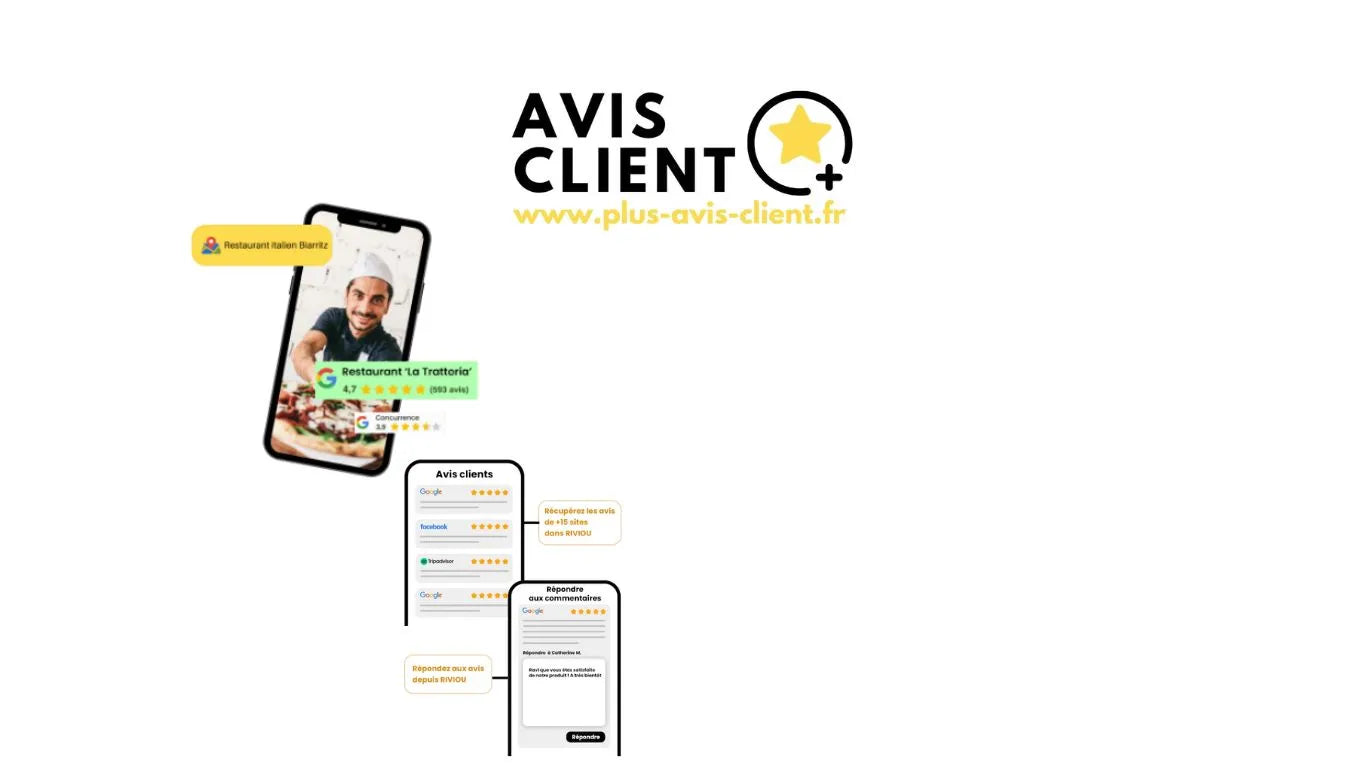
How to Handle Constructive Criticism to Improve Your Business
Summary
- Managing criticism and transforming it into useful feedback
- Differentiate between constructive and destructive criticism
- How to Handle a Critical Person at Work
- Turning negative feedback into positive action
- Moderation and management of online reviews
- Feedback culture and management of criticism in teams
- Frequently Asked Questions
In the professional world, the ability to handle criticism is an essential skill, whether it comes from customers or colleagues. To progress and build a relationship of trust, it is essential to welcome comments with an open mind and respond to them with a constructive approach . This guide offers you a concrete method for understanding and using this feedback on a daily basis, making each feedback a real springboard to enrich your customer experience and optimize your work environment.
Managing criticism and transforming it into useful feedback
Facing criticism can seem overwhelming at first, especially when it seems negative . However, mastering this feedback effectively allows for constructive exchanges that benefit everyone. Turning feedback into opportunities is a key quality of successful professionals and businesses.

How to Handle Criticism Effectively
The first step is to assess the nature of the feedback : is it constructive and factual, or an emotional reaction? This analysis will determine your strategy and attitude .
Practice attentive listening and demonstrate understanding. Try to fully understand the customer's or colleague 's perspective before responding. A prompt response (ideally within 48 hours) mitigates negative impact and demonstrates your professionalism.
- Classify the comments according to the Eisenhower matrix (urgent/important)
- Apply the Covey method: focus on what you can change
- Reframe criticism into constructive, actionable feedback
- Group non-urgent returns for scheduled exchanges
- Assign the follow-up of small comments to a colleague
- Evaluate the effectiveness of corrections through quick surveys
Offering concrete solutions (partial refund, voucher , exchange) often remains the best way to restore trust, even in the most complex situations.
The role of constructive feedback
Constructive feedback is a powerful lever for improvement. Every properly received criticism offers an opportunity to improve your methods. Always express your gratitude before using the feedback to improve your processes.
Favor personal statements ("I") to avoid judgment and maintain a constructive dialogue. This method allows you to highlight positive aspects before addressing areas for improvement.
Using digital tools in treatment
To effectively manage your online reputation, centralize your reviews on a single platform. The Master the Art of Negative Review Management solution brings together reviews from Google, Facebook, and TripAdvisor in a single place.
- Automate collection and responses (alert for scores below 3/5)
- Periodically analyze trends ( positive , neutral, negative)
- Use this data to solve problems at their source
This digital management lightens the manager 's load while considerably increasing the company's responsiveness.
Differentiate between constructive and destructive criticism
In a professional context, correctly identifying the different types of criticism allows you to adapt your strategy and take full advantage of useful feedback .
What are the two types of criticism?
There are two main forms of feedback:
- Constructive criticism: based on factual elements, its objective is to concretely improve the work .
- Destructive criticism: marked by subjectivity, it often resembles an unproductive personal judgment .
To properly analyze a remark:
- Consider the position of the interlocutor: a superior , a colleague or a subordinate.
- Adapt your response according to the person's level of expertise and role.
- Take into account the emotional context (busy period, possible tensions).
- Distinguish objective observations from personal opinions.
- Use even negative feedback as levers for improvement.
Examples of constructive criticism at work
Here are some effective formulations for good feedback:
- "This report would be clearer if you condensed this part."
- “What changes would you suggest to make this data more visible?”
Highlighting examples of criticism made by a colleague encourages constructive exchange and strengthens collaboration.
How to Handle a Critical Person at Work
In the professional world, it is common to face particularly critical colleagues or collaborators. For a manager , adopting the right attitude in these situations is essential to maintain good team dynamics. The ideal approach is to transform these criticisms into opportunities for improvement while maintaining a positive work environment.
How to deal with someone who is always critical
Covey's Circles of Influence method provides an effective framework for managing these interactions. It helps differentiate between what's truly within our control and what's up to management. When you receive criticism , try reframing it as open-ended questions: this allows you to base the discussion on concrete facts rather than impressions.
This strategy will prevent you from emotional reactions and help you maintain a professional posture in all circumstances.
- Convert judgments into constructive feedback : "If I understand correctly, you think the presentation lacks numerical data..."
- Organize regular points to collect and channel feedback , which prevents the accumulation of negative remarks.
Strategies for channeling recurring criticism
Implementing monthly collaborative workshops allows for the integration of various feedback into a continuous improvement approach. The Eisenhower matrix is then very useful for prioritizing corrective actions to be implemented.
Integrating feedback into group dynamics
At the end of each project, plan a review session where criticisms will be objectively analyzed to turn them into real levers for progress.
- Identify trends in feedback to identify recurring areas for improvement
- Communicate regularly (quarterly for example) on the main indicators from customer and internal feedback
| Nature of the criticism | Recommended approach | Responsible |
| Objective observation | Immediate corrective action plan | Operational Manager |
| Personal judgment | Reframing towards a constructive exchange | HR Manager |
| Side note | Treatment during periodic reviews | Dedicated project manager |
Adopting a good professional attitude toward criticism means, above all, knowing how to listen actively and systematically transforming feedback into concrete ways to improve teamwork . It is this approach that will make the difference in the long run.
Turning negative feedback into positive action
Receiving criticism can be awkward at the time, but it's actually a great opportunity for growth. It all depends on how you choose to respond to these comments. Adopting a constructive and thoughtful approach can completely transform the situation.
Methods to value each customer return
- React without delay (ideally within 48 hours) to limit the negative impact.
- Offer a personalized solution: a voucher , an additional service, or a suitable compensation. For example, in a restaurant, offer a gourmet coffee to compensate for a dish that's too spicy.
- Thoroughly analyze the cause of the problem (failing process, lack of training, insufficient quality control).
- Implement corrective measures and keep the customer informed of changes.
We always recommend thanking the customer warmly for their feedback - this encourages them to continue to express their opinion constructively.
Plan follow-up and measure improvement
- Monitor the evolution of customer satisfaction after the implementation of corrections.
- Send specific surveys to customers who have reported a concern.
- Present tangible improvements during strategic meetings.
To learn more, check out our complete guide: Turning Reviews into Progress Tools .
Moderation and management of online reviews
In the digital age, moderating interactions is crucial to maintaining a positive image on the Internet.

Filter negative reviews without harming the exchange
Our team removes offensive comments while allowing a cooling-off period before responding . This approach ensures a balanced and helpful response .
- Do not fall into excessive self-censorship for fear of judgment
- Save minor remarks for later group review
- Making the most of platform moderation features
Protecting e-reputation through moderation
By exploring complex criticism with an expert, we develop a collaborative method that improves the manager 's conflict management skills and their ability to turn unfavorable feedback into an advantage.
Feedback culture and management of criticism in teams
Establishing a feedback culture within a team strengthens collective performance while valuing the contribution of each member.
Training and workshops to improve feedback
- Organize regular individual interviews to encourage positive and constructive feedback .
- Conduct collective debriefings after each important mission.
- Train in the principles of Nonviolent Communication (NVC) with emphasis on personal formulations.
- Put the 5 Whys method into practice to identify the root causes of problems.
- Establish a quarterly review of returns and disseminate the main lessons learned.
Measuring the impact of integrated reviews
We define key indicators and systematically collect feedback through regular surveys to measure progress.
Communicate progress following a return
- An internal newsletter to inform about improvements made.
- A dashboard shared in real time with the entire team.
- Team milestones to celebrate progress.
- Continuous updating of customer documents.
Proper management of criticism and feedback requires constantly evolving your method in order to maintain a constructive dynamic.
Frequently Asked Questions
How to handle criticism?
Knowing how to handle criticism is a key skill in the workplace . Dealing with this feedback requires listening, time for reflection (ideally within 48 hours), and tailored responses. The Eisenhower Matrix will help you prioritize actions. Consider each complaint as valuable feedback for improvement—and regularly analyze the effectiveness of your responses.
What are the two types of criticism?
The types of criticism fall into two basic categories:
- Constructive criticism , anchored in specific facts, which offers real potential for improvement
- Destructive criticism, often emotional and poorly argued
Prioritize objective and recurring feedback for tangible impact.
How to deal with someone who is always critical?
When faced with a hypercritical profile, adopt three key approaches:
1️⃣ Practice active listening with targeted questions
2️⃣ Systematically refocus on factual elements
3️⃣ Establish structured feedback channels
This professional approach allows us to transform tensions into opportunities while preserving the quality of relationships.

